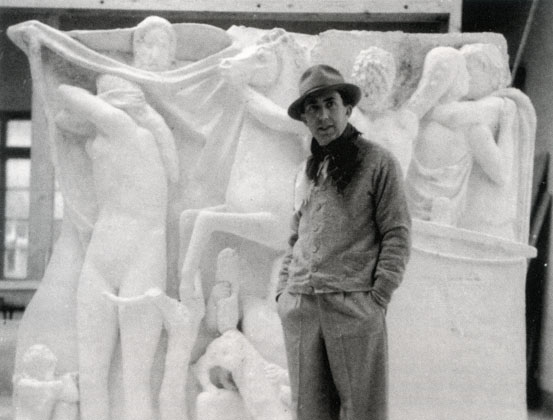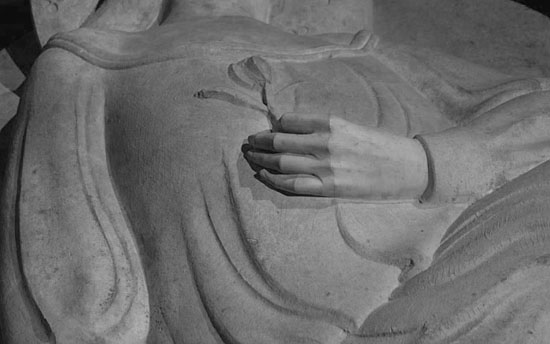
Recentemente mi hanno regalato il catalogo (Skira) della mostra su Arturo Martini, a cura di Claudia Gian Ferrari, Elena Pontiggia e Livia Velani esposta tra il 2006 e il 2007 alla Fondazione Stelline e al Museo della Permanente di Milano e alla Galleria Nazionale d’Arte Moderna di Roma. Sono andato a leggermi la cronologia a cura di Elena Pontiggia e arrivato alla fine ho letto:
22 marzo 1947. Muore improvvisamente a Milano, a cinquantasette anni.
Il giorno prima era stato colto da un ictus ed era stato ricoverato all’ospedale Fratelli. Ricorda Vergani: “Aveva il fianco destra paralizzato e faceva cenno perché intendessero il suo strazio di non poter più lavorare. La sua amica mi disse ch’egli chiedeva una rivoltella: avrebbe voluto uccidersi. (…) Al suo capezzale (…) ho visto Manzù lacrimare, Marini non diceva nulla. Messina – l’altro epurato – stava in disparte. Quei tre uomini non potevano comprendersi e perdonarsi nemmeno davanti alla morte. (…) Non ho mai visto una scena di più alta nobiltà nell’incontro tra la moglie di Martini, la figlia del fornaio di Vado Ligure, e l’amica, che viveva con lui da più di vent’anni. L’amante ha consegnato alla moglie tutto ciò che aveva del morto: le chiavi, l’orologio, il libretto degli assegni, i piccoli conti pagati. Tutte e due poi sono andate a vegliare Arturo, nella camera mortuaria dell’ospedale: la moglie accarezzando ogni tanto sul viso il cadavere, l’amante accarezzandogli le ginocchia. Io solo ho visto questa scena incomparabile. Le due donne non si erano mai conosciute (Orio Vergani, Misure del tempo. Diario, 1990″.
Due immagini che sarebbero potute essere rappresentate in sculture dello stesso Martini: i tre artisti che visitano il collega e rivale morente e le due donne che vegliano la salma dell’uomo che fu marito e amante. Entrambe hanno un che di umano e contraddittorio. Quel gesto di Egle, poi, che restituisce a Brigida l’orologio e il libretto degli assegni di Arturo… È tanto struggente che sembra quasi inventato.


I recently received as gift the catalog oh Arturo Martini’s exhibition, edited by Claudia Gian Ferrari, Elena Pontiggia and Livia Velani. The show took place between 2006 and 2007 at Fondazione Stelline and Museo della Permanente in Milan and Galleria nazionale d’arte moderna in Rome. I read the chronology by Elena Pontiggia and I finally found this:
March 22, 1947. He died suddenly in Milan, at fifty-seven.
The day before had been seized by a stroke and was hospitalized at Fatebenefratelli Hospital. Vergani Remember: “His right side was paralyzed and beckoned to intend his terror of being unable to work. His friend told me that he asked a revolver, he wanted to kill himself. (…) At his bedside (…) I saw Manzù crying, Marini said nothing. Messina – the other purged – stood apart. Those three men could not understand and forgive even before death. (…) I’ve never seen a scene of higher nobility in the encounter between Martini’s wife, the baker’s daughter in Vado Ligure, and her friend, who lived with him for over twenty years. The lover gave to the wife everything she had belonging to the dead: keys , the clock, the checkbook, small accounts paid. Then both of them came in the morgue of the hospital and held a wake over Arturo: his wife caressing every now and then the corpse’s face, the lover fondling his knees. I was the only one tosee that incomparable scene. Both women had never known (Orio Vergani, Misure del tempo. Diario, 1990)”.
Two images that could have been represented in Martini’s sculptures: the three artists who visit the dying colleague and rival, and the two women who watch over the corpse of the man who was husband and lover. Both have a kind of human hearing. That gesture of Egle, then, returning to Brigida Arturo’s clock and checkbook… It is so heartbreaking that it almost seems invented.
